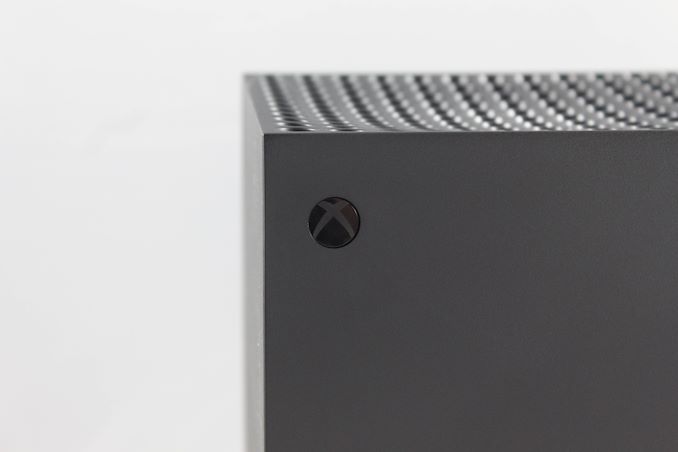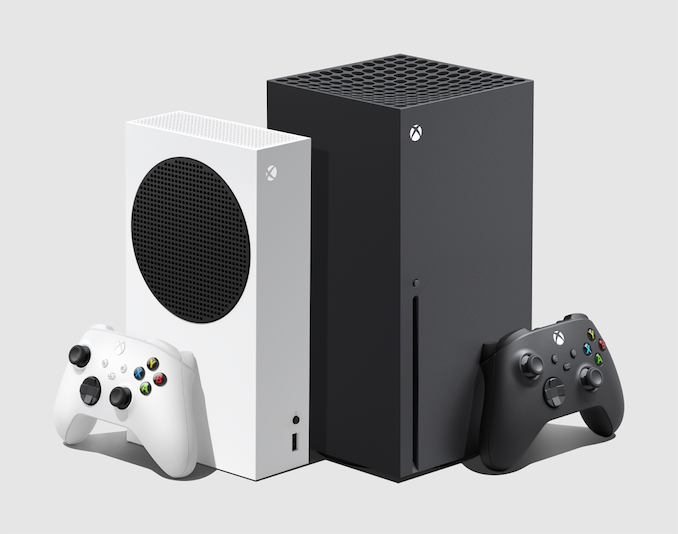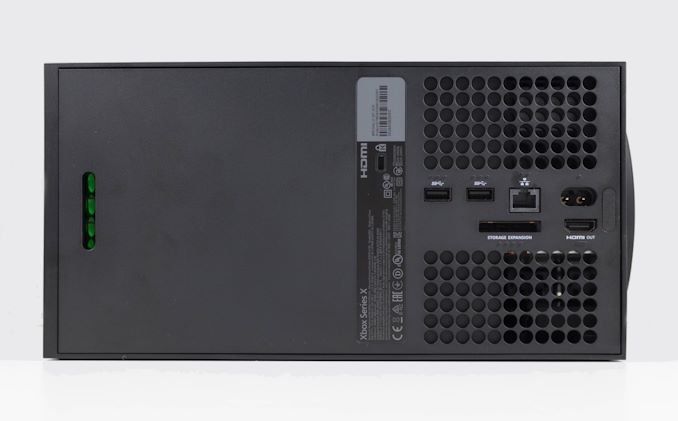The Xbox Series X Review: Ushering In The Next Generation of Game Consoles
by Brett Howse on November 5, 2020 9:00 AM EST
What makes a console generation? The lines have been blurred recently. We can state that the Xbox Series X, and its less-powerful sibling, the Series S, are the next generation consoles from Microsoft. But how do you define the generation? Just three years ago, Microsoft launched the Xbox One X, the most powerful console in the market, but also with full compatibility with all Xbox One games and accessories. With multiple tiers of consoles and mid-generation refreshes that were significantly more powerful than their predecessors – and in some cases, their successors – the generational lines have never been this blurred before.
None the less, the time for a “proper” next generation console has finally arrived, and Microsoft is fully embracing its tiered hardware strategy. To that end, Microsoft is launching not one, but two consoles, with the Xbox Series X, and the Xbox Series S, each targeting a difference slice of the console market both in performance and price. Launching on November 10, 2020, the new Xboxes bring some serious performance upgrades, new designs, and backwards compatibility for not only the Xbox One, but also a large swath of Xbox 360 games and even a good lineup of games from the original 2001 Xbox. The generational lines have never been this blurred before, but for Microsoft the big picture is clear: it’s all Xbox.
The Xbox Series X is the flagship console, and the one we have been teased about for over a year. When launched, it will be the most powerful console in the market. Microsoft learned some lessons from the original Xbox One launch, and they seem keen to not make those mistakes again, so they have partnered with AMD to deliver a console with eight Zen 2 CPU cores paired with an AMD RDNA 2 graphics processor with 12 TFLOPS of performance. With 16 GB of GDDR6 memory, and 1 TB of solid-state storage, the new Xbox Series X targets gamers looking for 4K gaming at 60 FPS, with up to 4K 120 FPS on some titles.
The Xbox Series S goes a different route, with a much more cost-effective console. It still features AMD Zen 2 CPU cores, but a much smaller 4 TFLOP GPU, which is not even as powerful as the Xbox One X from 2017. With 10 GB of GDDR6 and 512 GB of solid-state storage, the Xbox Series S targets 1440p gaming, or, more realistically for televisions, 1080p at up to 120 FPS, and with a large number of people still owning 1080p televisions, the less-expensive console has a definite niche.
Both consoles offer solid-state storage, which is one of the key features of the new generation. While not a new idea, solid-state offers a significant number of performance benefits as have been realized in the PC space for a decade or more, but cost has been prohibitive before.
With any console generation, the glue that holds it together is the games, and Microsoft has chosen a very different course for the Xbox Series X|S. With full backwards compatibility, there is already a large library of games, and games developed for the new consoles will continue to be available on the Xbox One as well, at least for now. Exclusives that are just for the Xbox Series X|S do not exist, which is certainly not how most console launches go. Instead, Microsoft sees the future of gaming in the Xbox Game Pass, which is a subscription service to a buffet of gaming titles.
| Xbox Specification Comparison | ||||||||||||||
| Xbox Series X | Xbox Series S | Xbox One X | Xbox One S | |||||||||||
| CPU Cores | 8C/16T | 8C/16T | 8C/8T | 8C/8T | ||||||||||
| CPU Frequency | 3.8 GHZ 3.6 GHz w/SMT |
3.6 GHZ 3.4 GHz w/SMT |
2.3 GHz | 1.75 GHz | ||||||||||
| CPU µArch | AMD Zen 2 | AMD Zen 2 | AMD Jaguar | AMD Jaguar | ||||||||||
| GPU Cores | AMD RDNA 2 52 CUs 3328 SPs 1.825 GHz |
AMD RDNA 2 20 CUs 1280 SPs 1.565 GHz |
AMD GCN 2 40 CUs 2560 SPs 1172 MHz |
AMD GCN 2 12 CUs 768 SPs 914 MHz |
||||||||||
| Peak Shader Throughput | 12 TFLOPS | 4 TFLOPS | 6 TFLOPS | 1.4 TFLOPS | ||||||||||
| Embedded Memory | None | None | None | 32MB eSRAM | ||||||||||
| Embedded Memory Bandwidth | None | None | None | 218 GB/s | ||||||||||
| System Memory | 16GB GDDR6 | 10GB GDDR6 | 12GB GDDR5 | 8GB DDR3-2133 | ||||||||||
| System Memory Bus | 320-bit | 128-bit | 384-bit | 256-bit | ||||||||||
| System Memory Bandwidth | 10 GB @ 560 GB/s 6 GB @ 336 GB/s |
8 GB @ 224 GB/s 2 GB @ 56 GB/s |
326 GB/s | 68.3 GB/s | ||||||||||
| Storage | 1 TB SSD 802 GB Free |
512 GB SSD 364 GB Free |
1 TB HDD | 500 GB HDD | ||||||||||
| Manufacturing Process | TSMC 7nm | TSMC 7nm | TSMC 16nm | TSMC 16nm | ||||||||||
| Dimensions | 151mm x 151mm x 301mm | 151mm x 275mm x 65mm | 300mm x 240mm x 60mm | 295mm x 230mm x 65mm | ||||||||||
| Weight | 4.44kg | 1.92kg | 3.81kg | 2.9kg | ||||||||||
| PSU | 315W (Internal) |
165W (Internal) |
245W (Internal) |
120W (Internal) |
||||||||||
| Optical Drive | UHD Blu-Ray | None | UHD Blu-Ray | UHD Blu-Ray | ||||||||||
| Wireless | 2x2 802.11ac | 2x2 802.11ac | 2x2 802.11ac | 2x2 802.11ac | ||||||||||
| Launch Price (USD) | $499 | $299 | $499 | $299 | ||||||||||
| Launch Date | 11/10/2020 | 11/10/2020 | 11/07/2017 | 08/02/2016 | ||||||||||
Microsoft has blurred the generational lines significantly with the Xbox Series X|S launch in quite a few ways, and accessory support is definitely one of them. In past console generations, new consoles would have new controllers and all new accessories would be required. That is not the case with the Xbox Series X|S. All Xbox One controllers are 100% compatible, as should be most other accessories such as headphones, and even the Xbox Adaptive Controller. There is one major accessory which is not compatible though, and that is Kinect. Kinect was a major focus of the Xbox One launch, but Microsoft quickly dropped the expensive accessory from being a requirement, and its use-case never materialized in any significant way. Xbox One games that require Kinect will not be compatible with the new Series X|S but all other Xbox One games will be through backwards compatibility. If you still use Kinect and enjoy it, this may seem like a step back, but from personal experience, Kinect will not be missed.
Another loss moving into this generation is the HDMI input which is no longer available. As part of the media push for the Xbox One, it included an HDMI input so you could insert the Xbox between your cable box and TV, allowing cable to be controlled via an IR blaster which could be plugged into the Xbox One. This had some advantages, but the media usage with DVR recording functionality ultimately never materialized, and there were likely only a small group of people taking advantage of this feature.
With the console features that define generations a short list indeed, let us now dig into the technical specifications of the new consoles so we can determine if these are indeed generational updates.












68 Comments
View All Comments
jabber - Thursday, November 5, 2020 - link
Tough call releasing a very non-essential bit of tech in the middle of a pandemic and economic downturn.Yojimbo - Thursday, November 5, 2020 - link
Gaming is strong because people are going out less, and it's not really an economic downtown. More like a big interruption. It remains to be seen what the longer-term effects are. Gaming tends to hold up well in actual economic downturns, anyway, from what I remember hearing. Evidence to expect strong sales: Typically, console sales are weak before a new console launch, but the PS4 and X Box One continued to sell well this year. And just look at how the Nintendo Switch is doing, much better than last year.cmdrdredd - Monday, November 9, 2020 - link
Not such a tough call when the Nintendo Switch and PS4 Prop have been sold out in most retail channels continuously since April.zepi - Thursday, November 5, 2020 - link
They are so badly supply side constrained, that there is really very little need to spend the marketing dollars right now.I'm sure MS and Sony will start pushing advertising once they have actually something to sell and they can really start competing for the marketshare.
steezebuscemi - Friday, November 6, 2020 - link
I haven't seen anything on TV, but also never really pay attention to free to air. But everywhere I look on the internet for the past 6-9 months has been speculation, rumours and excitement over this console gen. So it might just be where you are looking. I'm getting a PS5, I know numerous people getting Series X's, and I know a heap that missed out on preorders for either.Zagor Te Nay - Monday, November 9, 2020 - link
Don't know, my environment (friends and colleagues) are quite excited... but more about PS5 that XSX.I feel MS took some - or a lot - of edge from the hype with their approach. Games available on older Xbox, new Xbox, PC, and then mushed up in easy to digest subscription. It just doesn't let new consoles stand out of the crowd much, it feels more like "one of many". Plus, there is no real look-what-it-can-do title on launch. Maybe new Forza or something would raise excitement a bit, but as it is, lineup is a bit lackluster.
I work in IT company, so yeah - geeky environment. I hear chitchats about Miles Morales, DualSense, GT7 wishes, fears and expectations... but not much about new Xbox. I know it is anecdotal, still it holds some value for people in my circle; everyone from the circle, looking for new console, will be getting PS5 - as the things are now. I'm yet to hear one person who has set targets on XSX. It also doesn't help that many are PC gamers, too.
d0x360 - Wednesday, November 18, 2020 - link
I'm pretty excited...well I was, I already have my series x so now I'm just happy. Especially since I won't be able to get my hands on an amd 5900 and a 6900xt until probably March due to supply.Jorgp2 - Thursday, November 5, 2020 - link
>This encompasses four key components, the first of which is the NVMe SSD itself which can handle 2.4 GB/s of uncompressed data. But to connect it to the system, and reduce CPU overhead, there is also a hardware decompression block,Then there is no need for them to have used a proprietary memory card, most high end NVMe drives would have been fast enough.
Silversee - Friday, November 6, 2020 - link
It's not proprietary memory. It's a proprietary slot-based package.I surmise that they wanted a design that was plug and play for consumers and did not require opening up the case or messing with M.2 slots. So, they created the card interface.
They have indicated that other vendors may be offering compatible storage as well, so we may see market forces reducing costs.
eastcoast_pete - Thursday, November 5, 2020 - link
My "want it now" for this was significantly dampened when it became clear that Microsoft's own Flight Simulator is not available for the Series X at launch. That was/is weird, and gives me pause about availability of games that can really take advantage of the power this thing has on offer. Don't like saying it, but it looks like SONY is doing a better job there with its PS5, and I am not a PS fan.